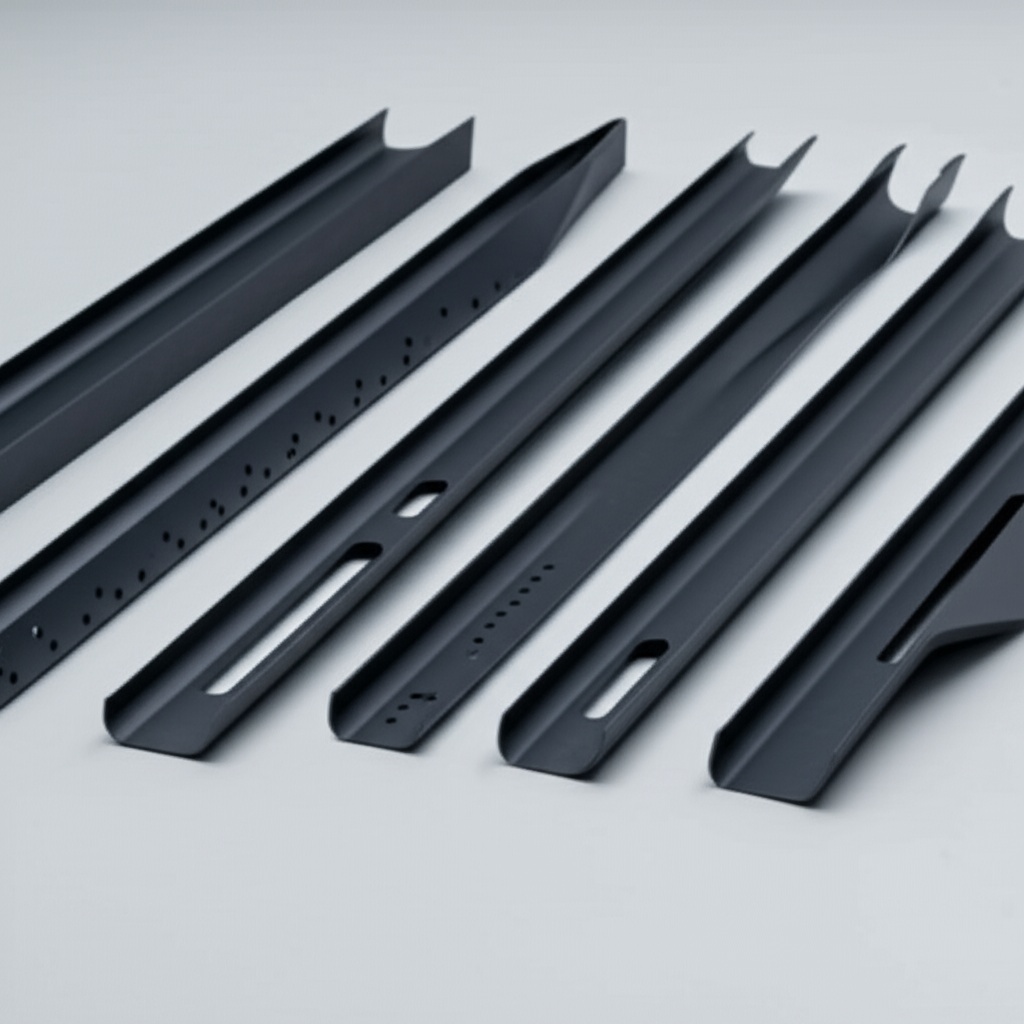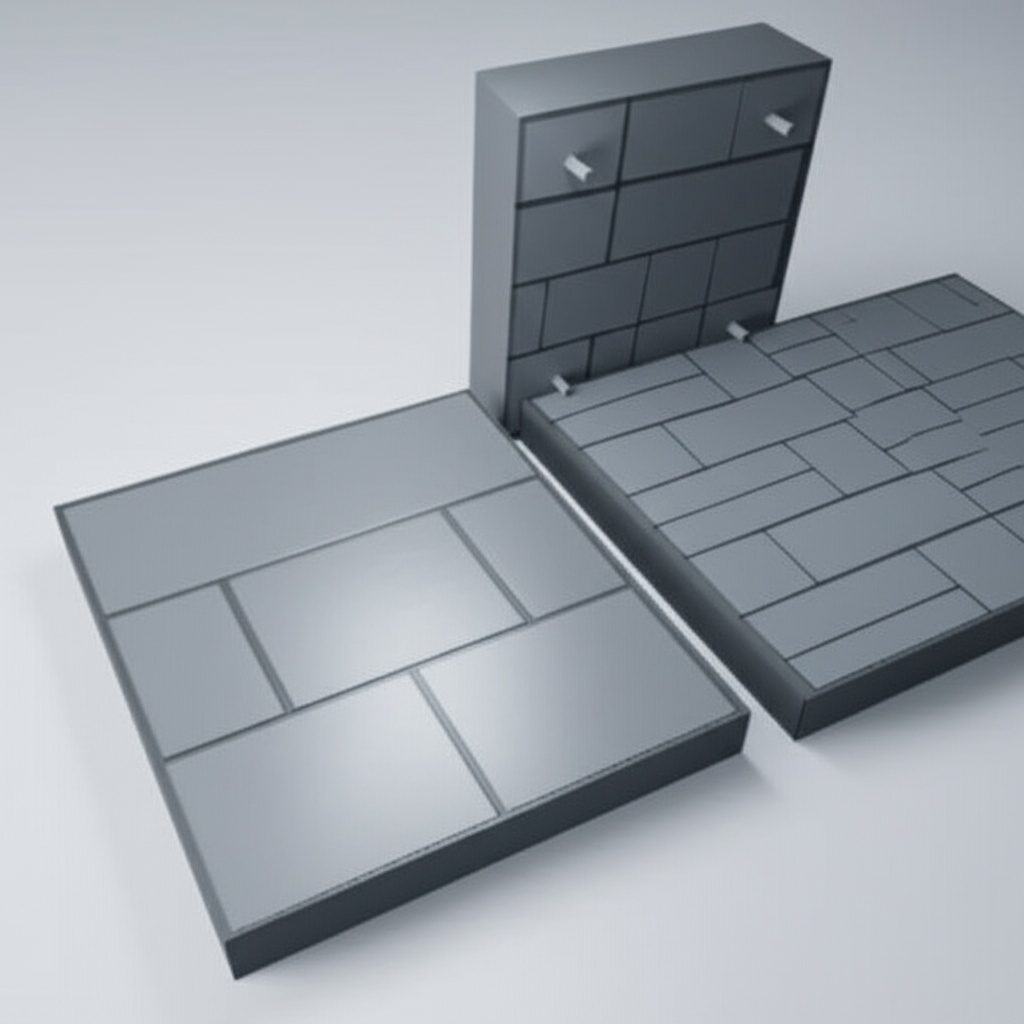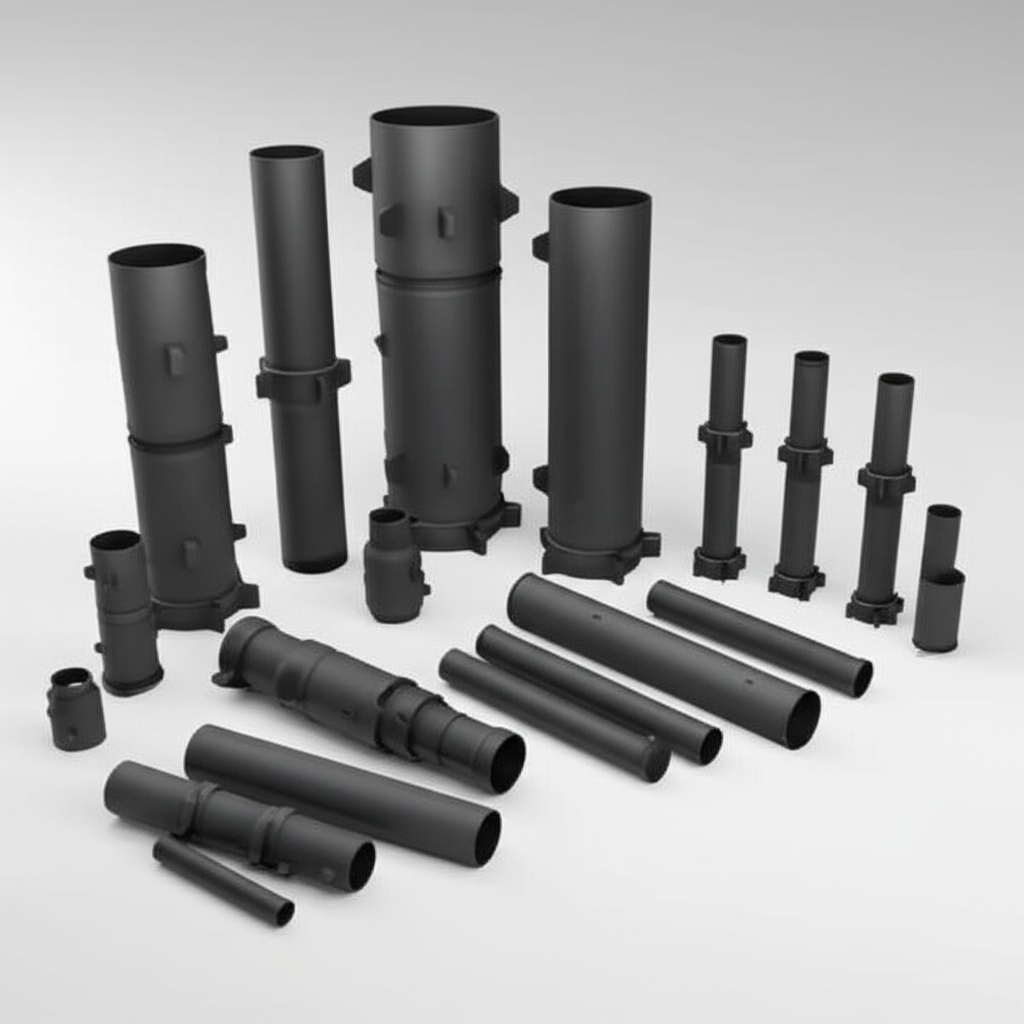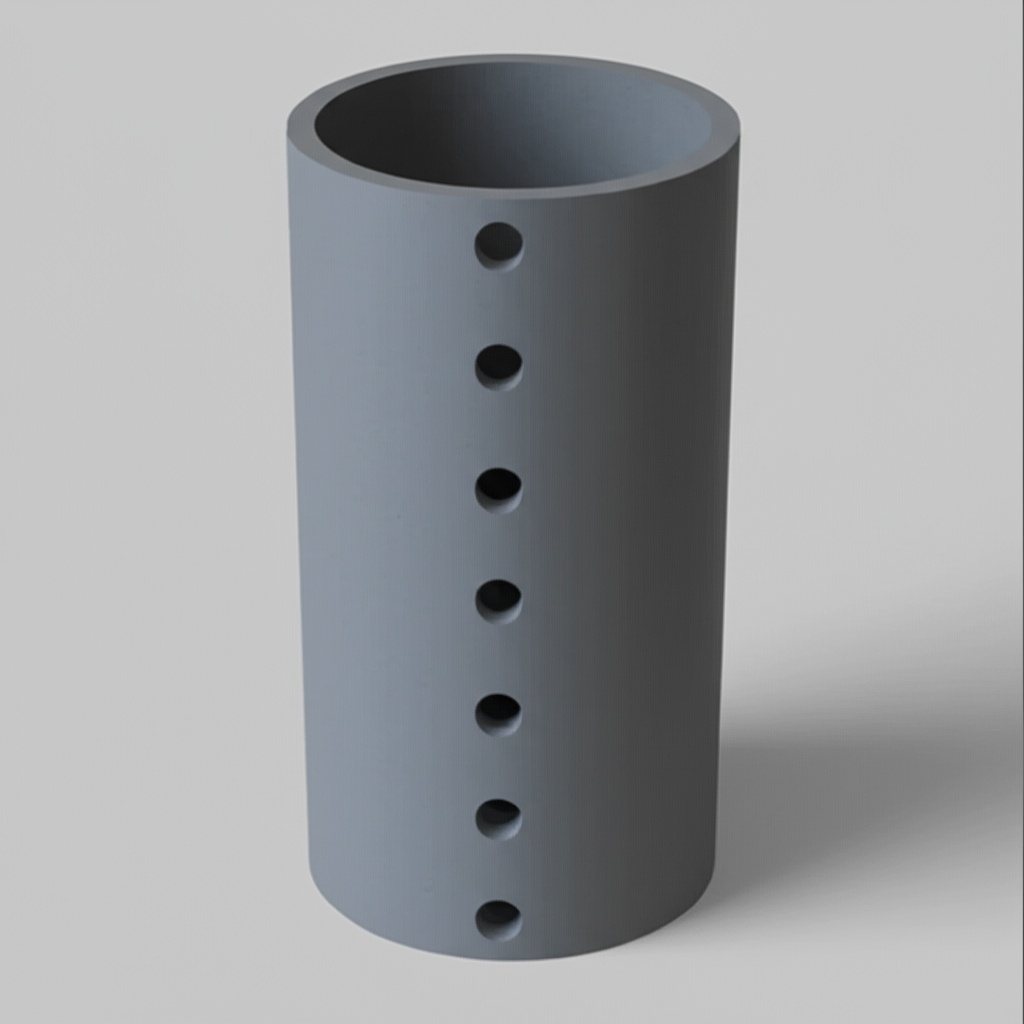SiC Corrosion Resistance for Lasting Durability

Compartilhar
SiC Corrosion Resistance for Lasting Durability
In demanding industrial environments, material degradation due to harsh chemical exposure is a constant threat. This is where the exceptional properties of custom silicon carbide (SiC) shine, particularly its unparalleled corrosion resistance. For engineers, procurement managers, and technical buyers across industries like semiconductors, aerospace, and energy, understanding the capabilities of advanced technical ceramics like SiC is paramount for ensuring the longevity and performance of critical components.
What is Custom Silicon Carbide and Why is it Essential?
Custom silicon carbide products are advanced technical ceramics renowned for their extreme hardness, high thermal conductivity, and remarkable chemical inertness. Unlike conventional materials, SiC offers a superior combination of properties that make it indispensable in applications where other materials fail. Its atomic structure, composed of strong covalent bonds between silicon and carbon, provides inherent resistance to a wide range of corrosive media, even at elevated temperatures.
The essence of “custom” SiC lies in tailoring the material’s composition, processing, and final geometry to meet the precise demands of a specific application. This bespoke approach ensures optimal performance and cost-effectiveness for compradores de atacado, profissionais de compras técnicas, OEMs e distribuidores seeking reliable solutions for extreme operating conditions. From intricate semiconductor processing equipment to robust components for high-temperature furnaces, custom SiC is the material of choice for lasting durability.
Main Applications of SiC Corrosion Resistance
The superior corrosion resistance of silicon carbide makes it a critical material across a diverse range of industries. Its ability to withstand aggressive chemicals and high temperatures extends the lifespan of components, reduces maintenance costs, and enhances operational safety.
- Fabricação de semicondutores: In highly corrosive plasma etching and chemical vapor deposition (CVD) processes, SiC components such as susceptors, liners, and process tubes are crucial for maintaining purity and preventing contamination. Its resistance to fluorine-based chemistries and high-temperature plasmas is unparalleled.
- Setor automotivo: As electric vehicles (EVs) become more prevalent, SiC power electronics are vital for inverters and on-board chargers due to their ability to operate efficiently at higher temperatures and voltages, resisting the corrosive effects of heat and electrical stress.
- Aeroespacial e Defesa: For components exposed to corrosive fuels, exhaust gases, or harsh atmospheric conditions, SiC offers reliable performance in jet engine parts, missile components, and thermal protection systems. Its high strength-to-weight ratio combined with corrosion resistance is a significant advantage.
- Eletrônica de potência: SiC devices are revolutionizing power conversion, enabling smaller, more efficient, and more reliable systems for everything from grid infrastructure to consumer electronics. Their inherent thermal stability and chemical resistance contribute to their long operational life.
- Energiezh adnevezadus: In solar inverters and wind turbine converters, SiC components handle high power densities and withstand environmental stressors, contributing to the efficiency and longevity of renewable energy systems.
- Metallurgy and High-Temperature Processing: SiC is extensively used in furnace linings, crucibles, and heat exchangers due to its resistance to molten metals, slags, and corrosive gases at extreme temperatures.
- Processamento químico: For pumps, valves, nozzles, and heat exchangers handling strong acids, alkalis, and solvents, SiC provides exceptional longevity, reducing downtime and replacement costs.
- Fabrikadur LED: SiC is used as a substrate for GaN-based LEDs, where its thermal properties and chemical inertness are crucial during epitaxy.
- Industrial Machinery: Wear parts in harsh environments, such as pump seals, bearings, and nozzles, benefit from SiC’s combined abrasion and corrosion resistance.
- Pellgehentiñ : In high-power radio frequency (RF) devices and base stations, SiC power devices offer superior performance and reliability, even in demanding environmental conditions.
- Eoul ha Gaz : Downhole tools and drilling equipment exposed to corrosive drilling fluids and high pressures leverage SiC for extended operational life.
- Medical Devices: For components requiring biocompatibility and resistance to sterilization agents, SiC offers a unique combination of properties.
- Rail Transportation: SiC-based power modules are being increasingly adopted in traction systems for trains, offering higher efficiency and reliability compared to traditional silicon-based solutions.
- Nuclear Energy: Due to its exceptional radiation resistance and thermal stability, SiC is being explored for advanced nuclear reactor components, including fuel cladding, where corrosion resistance in harsh environments is critical.
Advantages of Custom SiC for Corrosion Resistance
Choosing custom SiC offers several distinct advantages over standard materials, especially when corrosion resistance is a primary concern. These benefits translate directly into improved operational efficiency, reduced maintenance, and a lower total cost of ownership.
- Inerted Kimiek Dreist: SiC exhibits outstanding resistance to a broad spectrum of corrosive agents, including strong acids (hydrofluoric, sulfuric, nitric), alkalis, molten salts, and aggressive gases, even at elevated temperatures where most metals and ceramics would quickly degrade.
- Estabilidade em Alta Temperatura: Unlike many materials whose corrosion resistance diminishes significantly with increasing temperature, SiC maintains its integrity and chemical inertness even at temperatures exceeding 1500°C. This makes it ideal for high-temperature chemical reactors and furnaces.
- Rezistañs Dreistordinal ouzh ar Stok Termikel: SiC’s high thermal conductivity and low thermal expansion coefficient enable it to withstand rapid temperature changes without cracking or spalling, a common failure mode in less robust materials when exposed to thermal cycling in corrosive environments.
- Digeriñ Gwarez ha Pervezh Dreistordinal gant Goloioù Karbidenn Silikiom - CAS New Materials(SicSino) Beyond corrosion, SiC boasts extreme hardness, making it highly resistant to abrasion and erosion. This dual resistance is critical in applications where corrosive fluids also contain abrasive particles, such as slurries in chemical processing.
- Redução da contaminação: Its chemical inertness means SiC components do not leach impurities into process streams, which is crucial for sensitive applications like semiconductor manufacturing and pharmaceutical production where purity is paramount.
- Extended Lifespan and Reduced Downtime: By resisting corrosion and wear, SiC components significantly extend the operational life of equipment, leading to less frequent replacement and reduced downtime for maintenance and repairs.
Recommended SiC Grades and Compositions for Corrosion Resistance
Different SiC grades are optimized for specific applications based on their microstructure and bonding. Selecting the right grade is crucial for maximizing corrosion resistance and overall performance.
| Grau de SiC | Deskrivadur | Key Properties for Corrosion Resistance | Aplicações típicas |
|---|---|---|---|
| Silikiom Karbid Bondet Dre Argemmadur (RBSiC) | Porous SiC infiltrated with silicon metal, forming a dense composite. | Excellent chemical stability, good resistance to strong acids and bases. The free silicon phase can be attacked by strong alkalis at very high temperatures. | Mechanical seals, pump components, furnace furniture, nozzles, wear parts. |
| Carbeto de silício sinterizado (SSiC) | High-purity SiC powder densified at high temperatures without a metallic binder. | Superior chemical inertness, excellent resistance to almost all acids, alkalis, and molten metals. Maintains properties at very high temperatures. | Semiconductor processing components (susceptors, liners), high-temperature heat exchangers, chemical processing equipment, crucibles. |
| Silikiom Karbid Bondet Dre Nitrid (NBSiC) | SiC grains bonded by silicon nitride, offering a balance of properties. | Good corrosion resistance, particularly to acidic solutions, but generally less resistant than SSiC to strong alkalis due to the nitride bond. | Blast furnace components, kiln furniture, high-temperature refractories. |
| Chemical Vapor Deposited (CVD) SiC | High-purity, isotropic SiC formed by chemical vapor deposition. | Exceptional purity and chemical inertness, virtually no open porosity. Highly resistant to aggressive chemicals and plasma environments. | Semiconductor wafer carriers, optical components, high-purity crucibles, extremely corrosive environments. |
Design Considerations for SiC Products in Corrosive Environments
Effective design is crucial when working with custom silicon carbide, especially for applications where corrosion resistance is paramount. Considering the unique properties of SiC during the design phase ensures optimal performance and manufacturability.
- Minimize Stress Concentrations: SiC is a hard, brittle material. Designs should avoid sharp corners, abrupt thickness changes, and deep grooves that can act as stress risers, especially in environments with thermal cycling or mechanical stress.
- Uniformite Tezder ar Moger: Aim for consistent wall thicknesses to ensure uniform cooling and prevent internal stresses during manufacturing, which can lead to cracking. Gradual transitions are preferred.
- Consider Mounting and Fastening: When integrating SiC components, design appropriate mounting solutions that accommodate SiC’s lower thermal expansion compared to metals. Use compliant layers or careful clearance fits to prevent stress from differential expansion.
- Rekisoù Peurlipat Gorre: The desired surface finish can impact both performance and cost. A smoother surface generally offers better corrosion resistance by reducing surface area for chemical attack and minimizing sites for particle adhesion.
- Machinability Limitations: SiC is extremely hard, meaning it can only be machined effectively using diamond tools after sintering. Design complex geometries with this in mind to minimize post-sintering machining and associated costs.
- Gerenciamento térmico: While SiC has excellent thermal conductivity, consider heat dissipation paths in the design, especially for applications involving high temperatures or power dissipation.
Tolerance, Surface Finish & Dimensional Accuracy for Corrosion Applications
Achievable tolerances and surface finishes are critical factors that directly influence the performance and cost of custom SiC components in corrosive environments. Precision manufacturing ensures the integrity and longevity of the part.
- Tolerâncias dimensionais:
- Tel que cuit/fritté : For less critical dimensions, typical tolerances can range from ±0.5% to ±1.0%, with a minimum of ±0.1mm to ±0.2mm, depending on the size and complexity of the part and the SiC grade.
- Ground/Lapped: Post-sintering machining with diamond abrasives can achieve much tighter tolerances, often in the range of ±0.01mm to ±0.05mm, or even tighter for highly critical features.
- Gorread echuet (garvder):
- Tel que cuit/fritté : Surface finishes typically range from Ra 1.6 µm to Ra 6.3 µm, depending on the specific SiC grade and firing conditions. This can be sufficient for many general corrosion applications.
- Retificado/lapidado/polido: For applications requiring superior corrosion resistance, minimal particle adhesion, or high-purity environments (e.g., semiconductor processing), grinding, lapping, or polishing can achieve very smooth surfaces (Ra 0.1 µm to Ra 0.8 µm), or even mirror-like finishes (Ra < 0.1 µm). A smoother surface minimizes crevices where corrosive media can concentrate and prevents surface degradation.
- Key Considerations:
- Requisitos de inscrição: The required level of precision and surface finish should be driven by the specific demands of the corrosive environment and the component’s function.
- Cost Implications: Tighter tolerances and finer surface finishes increase manufacturing costs significantly due to the extensive diamond machining required. Balance performance needs with budget constraints.
- Live materiad: SSiC and CVD SiC generally allow for finer finishes and tighter tolerances due to their homogeneous microstructure and high purity.
Post-Processing Needs for Enhanced Corrosion Resistance
While SiC inherently offers excellent corrosion resistance, certain post-processing steps can further enhance its performance, especially in highly aggressive or specialized environments.
- Malanadur resis ha lapañ: Achieving a very fine surface finish through grinding and lapping is crucial for applications where minimizing surface area for chemical attack or preventing particle adhesion is critical (e.g., semiconductor processing, chemical pumps). A smoother surface reduces potential sites for corrosive media to accumulate.
- Polimento: For optical applications or ultra-high purity requirements where surface smoothness is paramount, polishing can achieve mirror-like finishes, further enhancing chemical inertness and reducing contamination.
- Coating (e.g., CVD SiC over porous SiC): In some cases, a high-purity CVD SiC layer can be applied over a more economical SiC substrate (like RBSiC) to create a highly corrosion-resistant, non-porous surface. This is particularly useful for applications requiring extreme purity and resistance to aggressive etchants.
- Vedação: For certain types of SiC (e.g., some forms of RBSiC with residual open porosity), sealing processes might be employed to further reduce permeability and enhance resistance to liquid or gas penetration in highly corrosive environments.
- Cleaning and Passivation: Proper cleaning protocols are essential to remove any manufacturing residues that could potentially react with corrosive media. In some cases, a passivation step might be considered to ensure the surface is in its most chemically inert state.
Common Challenges and How to Overcome Them
While silicon carbide offers remarkable advantages, engineers must be aware of certain challenges associated with its use and how to mitigate them.
- Frailadur: Like most technical ceramics, SiC is brittle and susceptible to catastrophic failure under tensile stress or impact.
- Mitigação: Design to minimize tensile stress concentrations, use compressive loading where possible, and employ careful handling procedures during manufacturing and installation. Finite element analysis (FEA) can help optimize designs.
- Complexidade e custo de usinagem: SiC’s extreme hardness makes it very difficult and costly to machine after sintering, requiring specialized diamond grinding tools.
- Mitigação: Design parts to minimize post-sintering machining. Utilize net-shape or near-net-shape manufacturing processes. Work closely with experienced SiC manufacturers who have advanced machining capabilities.
- Thermal Shock Sensitivity (though less than other ceramics): While SiC has excellent thermal shock resistance, extreme rapid temperature changes can still pose a risk, especially with complex geometries.
- Mitigação: Design with gradual temperature ramps, avoid abrupt changes in section thickness, and consider the thermal environment during material selection.
- Emglev hag Embennañ: Joining SiC components to themselves or dissimilar materials can be challenging due to differences in thermal expansion and the material’s inertness.
- Mitigação: Explore various joining methods such as active metal brazing, glass sealing, or mechanical fastening with compliant interlayers. Collaborate with suppliers experienced in SiC assembly.
- Pureza e Consistência do Material: Variations in raw material purity or manufacturing processes can affect the final properties, including corrosion resistance.
- Mitigação: Partner with reputable suppliers who maintain strict quality control, provide material certifications, and have a proven track record of consistent product quality.
How to Choose the Right SiC Supplier
Selecting the right custom silicon carbide supplier is paramount to the success of your project. A reliable partner will possess the technical expertise, manufacturing capabilities, and quality control systems to deliver high-performance components tailored to your specific needs.
- Technical Expertise and R&D Capabilities: Look for a supplier with deep knowledge of SiC material science, processing techniques, and application engineering. They should be able to advise on material selection, design optimization, and potential challenges. CAS new materials (SicSino), for example, leverages the robust scientific and technological capabilities of the Chinese Academy of Sciences (CAS), providing unparalleled R&D support.
- Comprehensive Material Options: Ensure the supplier offers a range of SiC grades (RBSiC, SSiC, CVD SiC, etc.) to match your specific corrosion, temperature, and mechanical requirements.
- Advanced Manufacturing Facilities: Assess their capabilities for net-shape forming, precision machining (diamond grinding, lapping), and advanced finishing processes crucial for SiC.
- Kontrol kalite hag testeniadennoù: A reputable supplier will have stringent quality management systems (e.g., ISO 9001) and provide detailed material certifications, ensuring consistent product quality and traceability.
- Experience in Your Industry: A supplier with a proven track record in your specific industry (e.g., semiconductor, aerospace, chemical processing) will better understand your unique challenges and requirements.
- Suporte à personalização: The ability to provide full customization, from initial design consultation to prototyping and full-scale production, is essential for specialized applications.
- Fiziañs Arvadañ: For critical components, assess their supply chain stability and ability to meet lead times. As you are aware, the hub of China’s silicon carbide customizable parts manufacturing is situated in Weifang City of China. Now the region has been home to over 40 silicon carbide production enterprises of various sizes, collectively accounting for more than 80% of the nation’s total silicon carbide output. We, CAS new materials (SicSino), have been introducing and implementing silicon carbide production technology since 2015, assisting the local enterprises in achieving large-scale production and technological advancements in product processes. We have been a witness to the emergence and ongoing development of the local silicon carbide industry.
- Customer Service and Technical Support: Responsive communication, technical support throughout the project lifecycle, and a willingness to collaborate are key indicators of a good partner.
Based on the platform of the national technology transfer center of the CAS, CAS new materials (SicSino) is belong to CAS (Weifang) Innovation Park, which is an entrepreneurial park that collaborates closely with the National Technology Transfer Center of the CAS (Chinese Academy of Sciences). It serves as a national-level innovation and entrepreneurship service platform, integrating innovation, entrepreneurship, technology transfer, venture capital, incubation, acceleration, and scientific and technological services.
CAS new materials (SicSino) capitalizes on the robust scientific, technological capabilities and talent pool of the Chinese Academy of Sciences (CAS). Backed by the CAS National Technology Transfer Center, it serves as a bridge, facilitating the integration and collaboration of crucial elements in the transfer and commercialization of scientific and technological achievements. Moreover, it has established a comprehensive service ecosystem that spans the entire spectrum of the technology transfer and transformation process. We possess a domestic top-tier professional team specializing in customized production of silicon carbide products. Under our support, 242+ local enterprises have benefited from our technologies. We possess a wide array of technologies, such as material, process, design, measurement & evaluation technologies, along with the integrated process from materials to products. This enables us to meet diverse customization needs. We can offer you higher-quality, cost-competitive customized silicon carbide components in China. We are also committed to assisting you in establishing a specialized factory. If you need to build a professional silicon carbide products manufacturing plant in your country, CAS new materials (SicSino) can provide you with the technology transfer for professional silicon carbide production, along with a full-range of services (turnkey project) including factory design, procurement of specialized equipment, installation and commissioning, and trial production. This enables you to own a professional silicon carbide products manufacturing plant while ensuring a more effective investment, reliable technology transformation, and guaranteed input-output ratio. This commitment to both local development and international partnership makes them a highly reliable and trustworthy partner for your custom SiC needs.
Cost Drivers and Lead Time Considerations for Custom SiC
Understanding the factors that influence the cost and lead time of custom silicon carbide products is crucial for effective project planning and budgeting. These advanced technical ceramics involve specialized manufacturing processes that differ significantly from conventional materials.
Sterioù Koust Pennañ:
- Material Grade and Purity:
- SSiC and CVD SiC: Generally more expensive due to higher purity raw materials and more complex processing. CVD SiC, in particular, is the most costly due to its deposition process, but offers unmatched purity and homogeneity.
- RBSiC and NBSiC: Typically more cost-effective for applications where their specific properties are sufficient.
- Part Complexity and Geometry:
- Intricate Designs: Parts with complex internal features, thin walls, tight radii, or non-standard shapes require more specialized tooling and manufacturing steps, increasing cost.
- Ment: Larger parts generally incur higher material costs and may require larger, more specialized furnaces or machining equipment.
- Redioù Usinerezh:
- As-Fired vs. Post-Sintering Machining: Components that can be produced near net-shape with minimal post-sintering grinding are more economical. Extensive diamond grinding, lapping, or polishing for tight tolerances or fine surface finishes significantly adds to the cost due to tool wear and labor.
- Gorread Echuiñ ha Gwirioù-dilez:
- Achieving extremely smooth surface finishes (e.g., Ra < 0.1 µm) or very tight dimensional tolerances (e.g., ±0.01mm) necessitates multiple stages of precision grinding and polishing, driving up manufacturing time and cost.
- Volume and Batch Size:
- Economía de escala: Larger production volumes typically lead to lower unit costs due to amortization of tooling, setup times, and raw material procurement advantages. Prototyping and small batch runs will have higher per-unit costs.
- Inspeção e Testes:
- Specific testing requirements (e.g., non-destructive testing, specific chemical resistance tests, or performance validations) can add to the overall cost.
Soñjal en Amzer Produiñ:
- Aquisição de materiais: Sourcing high-purity SiC raw materials can sometimes have lead times, especially for specialized grades.
- Tooling and Die Fabrication: For custom parts, the design and fabrication of molds or specialized fixtures can be a significant initial lead time factor.
- Processing Steps: SiC manufacturing involves multiple steps:
- Forming (e.g., pressing, extrusion, slip casting): Can take days depending on complexity.
- Sec'hañ: Critical to prevent defects, can take several days to weeks.
- Sintradur/Emglev Dre Adwezhiadur: High-temperature firing cycles are long and energy-intensive, often lasting several days.
- Usinerezh: Post-sintering diamond grinding and finishing can be time-consuming, especially for complex geometries or tight tolerances.
- Batching and Production Queues: Manufacturers typically operate in batches, so your order may need to wait for the next available production slot.
- Quality Control and Final Inspection: Thorough inspection and quality checks add to the overall lead time.
- Shipping: International shipping can add several days to weeks to the total lead time.
Typically, lead times for custom SiC components can range from 4-6 weeks for simpler parts in established production, to 12-20+ weeks for highly complex geometries, new designs, or larger batch runs requiring significant tooling. Early engagement with your supplier is key to managing expectations and ensuring timely delivery.
Perguntas frequentes (FAQ)
Here are some common questions about custom silicon carbide and its corrosion resistance:
-
Q: How does SiC compare to other technical ceramics in terms of corrosion resistance?
R: Silicon carbide generally offers superior corrosion resistance compared to other commonly used technical ceramics like alumina (Al2O3) or zirconia (ZrO2), especially in aggressive acidic or alkaline environments and at elevated temperatures. While alumina is excellent in many applications, it can be attacked by strong acids or bases at high temperatures. Zirconia can also have limitations in highly corrosive chemical baths. SiC’s robust covalent bonds provide a broader range of chemical stability.
-
Q: Can custom SiC components be repaired if they suffer damage?
R: Due to the extreme hardness and chemical inertness of silicon carbide, traditional repair methods like welding or conventional bonding are typically not feasible. Minor damage, such as chipping, might sometimes be addressed with specialized diamond grinding if the function of the component allows. However, for critical parts or significant damage, replacement is usually the most reliable solution. This emphasizes the importance of proper material selection and design to prevent damage.
-
Q: Is there a specific SiC grade that is universally best for all corrosive applications?
R: No, there isn’t a single “best” grade. The optimal SiC grade depends entirely on the specific corrosive media, operating temperature, pressure, and mechanical stresses involved. For instance, Sintered SiC (SSiC) is often preferred for its high purity and broad chemical resistance, particularly in semiconductor and extreme chemical processing. However, Reaction-Bonded SiC (RBSiC) offers a good balance of properties and cost-effectiveness for many general industrial applications where its free silicon content is not an issue. Consulting with a SiC material expert is crucial for making the right selection.
Conclusion: Ensuring Lasting Durability with Custom Silicon Carbide
In industries where material degradation due to corrosion is a constant threat, custom silicon carbide products offer an indispensable solution. Their unparalleled chemical inertness, high-temperature stability, and exceptional wear resistance translate directly into extended component lifespan, reduced maintenance costs, and enhanced operational reliability. From the high-purity demands of semiconductor manufacturing to the extreme conditions of chemical processing and aerospace, SiC stands as a testament to advanced material engi

SicSino - Novos materiais CAS
Nós, da CAS new materials (SicSino), estamos introduzindo e implementando a tecnologia de produção de carbeto de silício desde 2015, ajudando as empresas locais a obter produção em larga escala e avanços tecnológicos nos processos de produtos. Fomos testemunhas do surgimento e do desenvolvimento contínuo do setor local de carbeto de silício.





